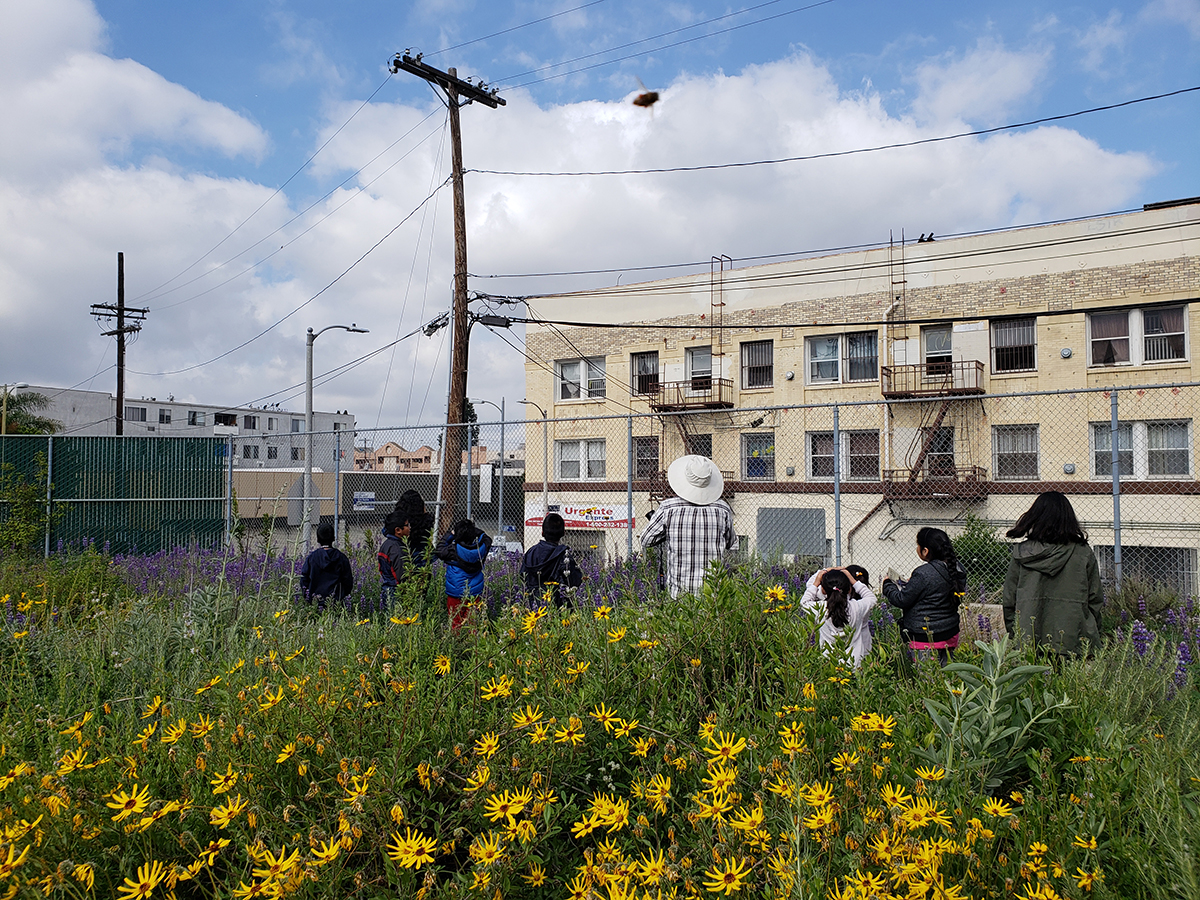By Emily Cobar, Community Program Manager
Parents and younger students observing the family of Egyptian Geese at MacArthur Park while one student looks for them in the Kaufmans field guide
Last year, junior staff of Los Angeles Audubon Society applied and received a scientific/research and community based grant by the Palos Verdes/South Bay Audubon Grant Program. Thanks to their generous funding, LA Audubon was able to produce 100 calendars filled with photographs and artwork made by the community including the schools’ principal, students, and their parents/guardians. In this project; staff, Baldwin Hills Greenhouse Program students and ee360 Fellowship interns led the Esperanza Elementary community in bilingual nature walks that bridged research, community engagement and art with non-scientists and non-researchers- a concept of community science.
Community Based Science
We did our nature walks in two locations: Esperanza Elementary School and MacArthur Park, both in the Westlake area- 2 miles West of Downtown LA. Although the landscape around these two locations are very urbanized surrounded with buildings, residential houses/apartments and stores, it is important to note that both the school and the park are enriched with wildlife. These areas are popular hotspots on eBird- an online database platform where people of all levels of birding report their bird observations.
The nature walks serve to talk about wildlife, plants and animals- in Los Angeles and to collect data for eBird. While we had younger students, parents and the principal spotting the birds and taking pictures, we had either staff, interns, or high school students collecting data on a clipboard. We had a team of great bird spotters for the Christmas Bird Count we did in early January, it was then that one parent spotted (and was later identified by the principal) a Plumbeous Vireo and another parent had spotted the Black-throated gray warbler at MacArthur Park.
Intergenerational Learning
ee360 intern, Joanna Ruacho and Greenhouse student, Kevin Mendizibal, engage with the younger students at Esperanza Elementary
The best part of the nature walks is that it was not only lead by LA Audubon staff, but led by a team of multiple people, including high school students of the Baldwin Hills Greenhouse Program, interns from my ee360 Fellowship project and college students from our Baldwin Hills Parklands Conservation Certificate Program. The older students gained mentorship skills while we hope the younger students spark interest in the conservation field and/or spark interest in becoming part of our Greenhouse Program once they are in high school.
Scientific Illustration In the Native Habitat
ee360 intern, Joanna Ruacho and Greenhouse student, Kevin Mendizibal, engage with the younger students at Esperanza Elementary
Along with photographs that participants took along the nature walks, we added a scientific illustration workshop which the younger students worked on in the native habitat. We emphasized that scientific illustration is not about having perfect drawing skills, but it is all about observation and focusing on detail. We know that drawing wildlife can be difficult as wildlife is always on the move so we used invertebrates encased in resin that may be found in the native habitat as the first part of the workshop. These invertebrates included: orb weavers, harvester ants, monarch butterfly, bee, and more. The second part of the scientific illustration workshop, the students went to the habitat to observe and draw the things that are always in place: California native plants. Students drew plants in the habitat such as California bush sunflower and Lupine species.
Breakfast and Birding
After eating coffee and chuchitos, a traditional Guatemalan-style tamales, families and students explored the native habitat
As a big thank you to the participants, we planned a breakfast and bird walk. We served coffee, fruit, black beans , and chuchitos (a traditional Guatemalan-style tamales) cooked by my mom-thanks mom! On that day we handed out the calendars which all participants in the walks received for free. Students were excited to see their artwork publish on it. Afterwards, we went bird and wildlife watching at the habitat. We saw birds like Parakeets and Cooper's Hawk-which a younger student tracked in her bird list and we saw many pollinators including a Gulf Fritillary. We used tools like iNaturalist and ebird to report our findings and spend the last half hour as playtime in the habitat.
Thank You to Funders
This was a very special project to me, not only because I got a chance to go bird-watching with the community within the busy city, but because this is my first experience in grant writing and grant reporting. Thank you to the Palos Verdes/South Bay Audubon for the funding for the calendars and the NAAEE ee360 for the funding to provide stipends for the college interns for participating in this project (Check out the September/October 2018 Western Tanager for more information)
Muchísimas Gracias a la Comunidad (A Big Thanks To The Community)
Esperanza families, the principal, Brad Rumble, ee360 interns and students pose in front of DTLA after receiving their calendars.
Gracias a todos que participaron a los paseos de la naturaleza guiados por nosotros de Los Angeles Audubon con la ayuda de Mr. Rumble. Espero que ustedes y sus hijas e hijos disfrutaron como nosotros disfrutamos estos días especiales de comunidad y ciencia. Hasta el próximo paseo!







